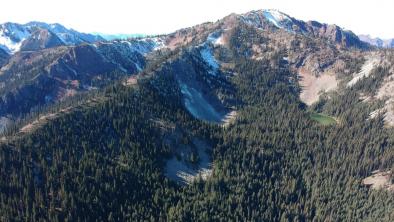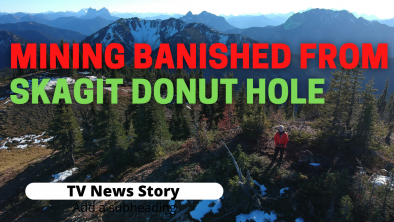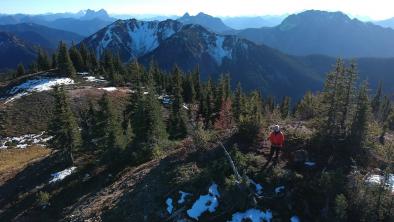Editorial: Ken Farquharson and Tom Perry: Horgan should cancel logging plans for Skagit Valley

Editorial: KEN FARQUHARSON & DR. TOM PERRY Vancouver Sun - July 8, 2018
B.C. Timber Sales is about to tender cutblocks in the Skagit Valley right beside Manning Provincial Park. Roadbuilding for logging high in the subalpine is ongoing as we write. This is against the interests of B.C. Parks and the requirements of the Skagit River Treaty. Premier John Horgan can stop it with a telephone call to the responsible minister.
Almost 50 years ago, alert citizens in Seattle discovered that Seattle City Light planned to raise Ross Dam and flood B.C.’s Skagit Valley. This launched one of Canada’s first great environmental battles, but in 1984 the dispute was resolved by the Skagit River Treaty between Canada and the U.S. The Treaty scuttled High Ross Dam, in return for B.C.’s sale of equivalent power to Seattle.
Hundreds of organizations and thousands of individual citizens in both Canada and the U.S. had worked to protect the Skagit from a provincial government too ignorant to realize what it had signed away for a pittance. The 1972-75 NDP government of then-premier Dave Barrett took the first steps to save the Skagit, but ultimately the Socreds, and especially the late Rafe Mair, sealed the deal.
A little known result of the Skagit River Treaty was creation of the Skagit Environmental Endowment Commission, or SEEC. B.C. and Seattle funded its endowment and each appoint commissioners with a mandate to:
• conserve and protect wilderness and wildlife habitat;
• enhance recreational opportunities in the Skagit Valley; and
• acquire mineral or timber rights consistent with conservation and recreation purposes.
Yet B.C. Timber Sales, a branch of the B.C. government, is now attempting to frustrate that mandate, and the long-term objective of B.C. Parks, on lands formerly protected within Manning Provincial Park.
After the Treaty was signed, another NDP government finally B.C. established the Skagit Valley Provincial Park in 1997. But government had also moved the western boundary of Manning Park to the east, to exclude mining claims known as the Giant Copper property. This left a pocket of open Crown land south of Highway 3 encompassing the mining claims but surrounded by parks, now usually known as the “donut hole”. The purpose was to avoid having to expropriate claims within a Provincial Park. B.C. Parks has always wanted to add these scenic lands to Skagit or Manning Provincial Park, once the claims were acquired.
SEEC has worked steadily on its mandate, acquiring claims at Galene Lake, at the western edge of Skagit Valley Park, and an inholding of private land on the floor of the valley. The Giant Copper property is a significant group of mining claims, so SEEC approached the previous B.C. government in 2016 seeking support to open negotiations with the owner, Imperial Metals. Government ministers encouraged SEEC to proceed. Seattle had already registered with B.C. its concerns regarding water quality in the Skagit system if the Giant Copper property were to be developed.
SEEC commissioned an evaluation of the property by a mining consultant, who concluded that the property was submarginal at present prices for copper, and would have great difficulty getting permitted. At a meeting earlier this year with senior staff from B.C. Parks and the Ministry of Mines, government again encouraged SEEC to negotiate with Imperial. An approach was made, but Imperial advised that a gold-bearing seam had been exposed. Discussion on the future of the property would have to wait until this was assessed.
The Skagit Environmental Endowment Commission’s approach to these mineral claims is based on its mandate for conservation of wilderness and wildlife habitat. Therefore, SEEC was shocked to learn in June that B.C. Timber Sales, a branch of the Ministry of Forests, Lands, Natural Resources and Operations, had prepared plans to log the upper parts of the Silverdaisy and Twentysix Mile drainages inside the donut hole. Road construction for logging has already begun, and breached two formerly pristine drainages. Logging these subalpine slopes, directly above Skagit Valley Provincial Park and protected spotted owl habitat frustrates the mandate of SEEC and the long-term objectives of B.C. Parks.
BCTS did not refer its plans to B.C. Parks or SEEC for comment. This information came to SEEC’s attention only through a tipoff from citizens. On the other hand, BCTS was well aware of SEEC’s intentions for the donut hole. Forest Ministry staff attended the meeting with Ministers in 2016, and also had direct advice from SEEC as to its environmental conservation objectives for these Crown lands. The only conclusion we can reach is that one arm of government is deliberately trying to frustrate another, plus the independent Commission established by international Treaty.
This is why the Skagit River Treaty, fruit of B.C.’s environmental movement, is so important. Is B.C., as a beneficiary of the treaty and a sponsor of SEEC, required to allow SEEC to fulfill its mandate, regardless of the preferences of some provincial ministries? SEEC believes the treaty endows it with that power and responsibility. It is raising this issue with Premier John Horgan and the mayor of Seattle. SEEC sees the end objective clearly: acquisition of the mineral claims and transfer of the “donut hole” to B.C. Parks. Given this land’s high scenic quality and environmental character, it’s a public benefit worth striving for. Where does the B.C. government now stand on the Skagit?
Ken Farquharson is a retired civil engineer who co-founded the Sierra Club of B.C. and chaired the Run Out Skagit Spoilers Committee; Dr. Tom Perry is a physician who was co-ordinator for ROSS and a former NDP MLA and minister of advanced education.


